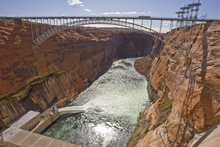This is an archived article that was published on sltrib.com in 2013, and information in the article may be outdated. It is provided only for personal research purposes and may not be reprinted.
The U.S. Bureau of Reclamation on Friday announced a historic move — it will cut water releases from Glen Canyon Dam next year, citing drought and the ever-dropping level of Utah's Lake Powell.
Back-to-back years of near-record low precipitation along with increasing demand on the Colorado River's liquid bounty gave the agency little choice but to reduce the mighty dam's outflow to its lowest amount since it inundated Glen Canyon in the mid-1960s.
Many river watchers characterized Friday's announcement as a renewed call to reverse the widening gap between demands on the river's water and its shrinking flow in the face of climate change.
"It's the fire under our feet. We can avoid the crisis if we are smart and move toward the solutions," said Bart Miller, water program director for the conservation group Western Resource Advocates. It's time for cities and farmers to step up conservation investments and promote better efficiency, groups say.
Recently named America's most endangered river by one conservation group, the Colorado drains the American Southwest and supplies water to some 30 million. Its flow is captured behind dozens of dams on the main stem and its tributaries, and not much is left by the time the river reaches the Sea of Cortez.
Reclamation operates Glen Canyon in tandem with its downstream partner Hoover Dam, which impounds Lake Mead, a key water source for Las Vegas and other lower Colorado River Basin users. The two reservoirs, which sit on each side of the Grand Canyon, are both less than half full, putting their ability to generate hydropower at risk.
"This is the worst 14-year drought period in the last hundred years," said Reclamation's Upper Colorado Regional Director Larry Walkoviak in a press statement Friday. "Reclamation's collaboration with the seven Colorado River Basin states on the 2007 Interim Guidelines is proving to be invaluable in coordinating the operations of the reservoirs and helping protect future availability of Colorado River water supplies."
Walkoviak was referring to an accord between the upper and lower basins — hammered out the last time declining levels at Lake Powell approached a crisis — as a way to equitably share the pain in shortage years. These guidelines require the upstream dam to curtail its annual releases by 750,000 acre feet should the lake's surface drop below 3,575 above sea level.
That's 125 feet below full pool and just 55 or 65 feet above the point where Glen Canyon's power-generation conduits begin pulling down air that would damage the turbines.
In its latest monthly report on Colorado River water availability, known as the 24-month study, Reclamation predicts that the 3,575-foot threshold will be breached in December. Accordingly, next year's releases will be cut to 7.48 million acre feet. Normally, annual releases are 8.23 million to meet obligations to the three lower-basin states and Mexico.
"With a good winter snowpack next year, the outlook could change significantly as it did in 2011, but we also need to be prepared for continuing drought," said Terry Fulp, Reclamation's lower Colorado regional director.
Last month, Lake Powell's 143,000 acre feet of inflow was only 13 percent of average, and more than 700,000 acre feet less than what was released, according to Reclamation's August update. The lake level peaked at 3,600 feet in June and is expected to bottom out next March at 3,567, even with the reduced outflow. These cutbacks are expected to lower Mead's level 8 to 10 feet.
While Powell remains at 45 percent capacity, upstream reservoirs serving Utah, such as Starvation and Strawberry, are in better shape. They are, after all, storing water that would otherwise flow into Powell.
"We don't have lots but we are OK for now," said Christine Finlinson, spokeswoman for the Central Utah Water Conservancy District. "We are hopeful if we can have average precipitation this winter we can maintain our normal deliveries. We have been able to help some communities that found themselves with severe shortages."
But Christi Wedig, executive director of the Glen Canyon Institute, contends Colorado River water would serve the greater good were more allowed to flow through Lake Powell.
The river's low flow "isn't a one-year problem. There is a long-term trend for less water. Why are we hoarding water in the upper basin if it's not being put to beneficial use?" Wedig said.
The river's water grows high-value vegetables, such as winter lettuce, in lower basin states, whereas it tends to irrigate alfalfa upstream of Powell. But Utah and the three other upper basin states are entitled to 7.5 million acre feet of the flow, which they insist on receiving in normal years.
"This attitude is going to head to litigation that will delay solutions and put us in a worse position than if we collaborated," Wedig said. "We have created this house of cards with subsidies stacked on each other. The bottom card is getting pulled out by climate change."
Wedig's and other groups are calling for an end to new dams and pipelines and keeping Mead full at Powell's expense.
Proposed diversions, such as the Lake Powell Pipeline to St. George, will exacerbate the crisis, critics argue.
But Utah water officials, downplaying the significance of the Glen Canyon cutbacks, said such steps are not necessary and the $1.5 billion 139-mile pipeline project is moving forward.
"The impact today on the system will be minimal," Dennis Strong, director of the Utah Division of Water Resources, said of the cutback. "What happens is we end up with a little more water in Lake Powell. That will protect our ability to deliver water downstream."





